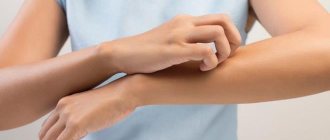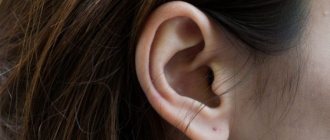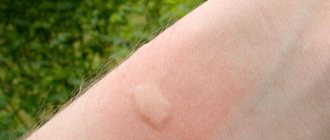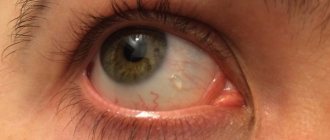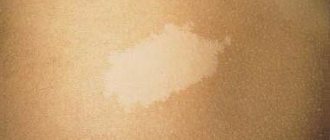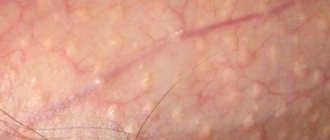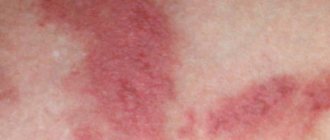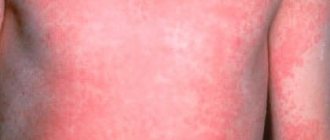Blisters on the ear: causes
Blisters are inflammations in the upper layer of the skin, which are characterized by clearly defined swelling, red or pinkish color, and the shape can be either blurry or clear.
Multiple vesicles - blisters, very similar to pimples, but with transparent contents, appear during an allergic skin reaction. But there are many more reasons when one or more blisters appear behind the ear:
- Insect bite: mosquito, midge, flea and others cause a slight swelling when bitten, which itches a lot
- Fungus: Fungal infections often cause a rash; if the infection occurs in the skin behind the ears, which is not uncommon, blisters and itching are likely.
- Miliaria: as on the fingers, in the armpits, behind the ears, where the skin often sweats under a warm hat, dyshidrosis can manifest itself.
- Friction: Sometimes a blister appears after intense rubbing of the skin behind the ear.
- Dermatitis: After contact with an irritating substance, contact dermatitis can appear behind the ear, where the skin is very delicate.
- Allergic reaction: hives after dyeing hair or changing shampoo or detergent appear and disappear within a few hours.
- Infection: chicken pox, measles, rubella and other infectious and highly contagious diseases occur with a rash in the form of blisters.
- Seborrhea: This disease can also affect the part of the scalp that is not covered with hair.
- Scrofula: many have not heard of this disease, meanwhile, grayish formations behind the ears, itchy and flaky - one of the most common diseases, it is caused by the tubercle bacillus, affects people (often children under 10 years of age, but sometimes adults), with a tendency to tuberculosis, weakened immune system.
- Neoplasms: often what a person mistakes for a blister does not go away for quite a long time; dense contents appear inside it, which keeps increasing, eventually forming not just a blister, but a huge “bump.” Such a blister may ultimately turn out to be either an epidermal cyst (benign tumor) or a malignant skin lesion.
- Otitis: inflammation can be both external and internal; itching and the appearance of a blister in the ear can also be the initial stage of otitis.
These and other reasons should force a person not to hesitate to contact a dermatologist, to follow his recommendations and advice regarding consultations with specialists - allergists, nutritionists, neurologists and venereologists.
Rash on ears and face
The most common cause of rashes on the face and ears is allergies. In this case, damage to the epidermis and impaired immunity are observed. Rashes in this area can occur during stressful situations and skin injuries.
Allergic dermatitis in the initial stages is characterized by red or bright pink spots, in the place of which small blisters subsequently appear. Subsequently, these blisters burst, and the rash takes the form of small, weeping ulcers. The patient feels a burning sensation and severe itching, and not only the affected areas of the skin can itch, but also the entire surface of the ears. Skin eczema has similar symptoms, however, with this disease all the symptoms are more pronounced.
What to do if it itches, scratch it or endure it?
No scratching, no matter how itchy the skin affected by the blister. A serious risk of infection arises due to the specific location of the irritation.
Constant friction with hair and hats contributes to the introduction of harmful bacteria into micro-wounds; even a tiny scratch heals here very slowly, and dermatitis will have to be treated for at least a week.
When affected by a fungus or infectious disease, the risk of spreading the disease with the liquid contained in the blister increases significantly, so herpes, fungus, and lichen can be “spread” throughout the body.
Description of the pathology
Herpes in the ear is a rare disease. The provocateur of development is, as a rule, the third type of herpes virus - Herpes zoster. Both women and men are equally susceptible to the disease. Main routes of transmission:
- contact;
- airborne;
- vertical.
If you do not touch the affected area with your hands or scratch it, then the symptoms are harmless, unless you take into account the unpleasant, tiring sensations.
First aid
One or more blisters that appear behind the ears should not be touched with bare hands, especially without treatment with an antiseptic.
If blisters appear where contact with a bandage, headdress or hair is inevitable, remove these squeezing and rubbing objects, put the hair in a ponytail, pin it up, comb it - do everything to avoid contact.
If you suspect an allergic reaction, remove substances that could cause it away: rinse off the hair dye immediately with plenty of water so that the blister does not develop into Quincke's edema (a life-threatening syndrome, which is essentially an ordinary but giant blister that causes suffocation), Wash off shampoos or gels with plenty of clean water.
- If there is a significant deterioration in health or shortness of breath, take the victim out into the fresh air, into a well-ventilated area.
- Give any antihistamine to relieve an exacerbation.
- Treat the surface behind the ears with an antiseptic.
- If severe itching occurs, apply ice; you can lubricate it with any remedy that relieves this symptom, from soda solution to Finalgon.
- If you feel unwell, call emergency medical help; if you feel well, go to the hospital to find out the cause of the blister.
Prevention
To prevent the development of a pathology such as herpes in the ear, it is necessary not to neglect some simple rules, which are as follows:
- a healthy lifestyle at all times Walk more and spend more time in the fresh air. This will significantly strengthen your immune system.
- Nutrition must be correct. In order to work properly and perform a protective function, the body requires a constant supply of vitamins, proteins and microelements.
- Before eating vegetables and fruits, it is recommended to wash and heat treat them.
- It is better if bad habits are forgotten forever. Alcohol and nicotine primarily negatively affect human immunity.
- Personal hygiene must always be observed . Hands should be washed with soap as often as possible. If this is not possible, you can use antiseptics, for example, Miramistin or Chlorhexidine.
- room temperature In winter, it is important not to expose the body to hypothermia, and in the summer – to overheat.
Blister Treatment Options
If formations on the skin appear unexpectedly, and it is impossible to seek medical help, you need to remember about methods of help at home. You can alleviate the condition both with the help of medications and folk remedies.
Pharmaceutical ointments, plasters
- Having noticed a blister, treat the skin around it with an antiseptic;
- if the blisters are not damaged, carefully apply ointment with a cooling effect to a cotton pad, apply to the skin, and secure with a bandage;
- if the blisters burst, it is enough to lubricate them with anti-inflammatory ointment Solcoseryl, Methylurocil, oxolinic or tetracycline;
- repeat every 4 to 6 hours, carefully monitoring the patient’s condition.
For allergies and burns, you need to use products designed to treat them.
Treatment of blisters on the ear with traditional medicine
A lotion of soda with added water is applied to the affected area for insect bites to relieve itching.
Aloe juice, raw potatoes, carrots will help stop itching and inflammation.
A decoction of chamomile, sage, and birch buds will relieve inflammation and itching.
- Mix 1 tsp. dry herbs and buds.
- Boil 1 l. water, add raw materials.
- Boil over low heat for 3 minutes.
- Cool, moisten a disc or gauze in the broth, and apply to the affected area.
- Change every 2 – 3 hours.
This flock will help with burns, dermatitis, and allergic reactions.
Primary contact dermatitis
Occurs as a result of direct contact of the skin with an irritant.
Types of damaging factors:
- Physical. Exposure to radiation, high or low temperature. In second-degree burns or frostbite, watery blisters appear on the surface of the skin. With a sunburn, blisters and detachment of the epidermis are observed.
- Mechanical, when pathological changes occur due to friction when wearing tight clothes or shoes (calluses on the feet).
- Biological, in which the damaging agent is either an insect bite (mite) or the action of a plant (nettle).
- Chemical - when the skin comes into contact with various substances that contain alkalis or high concentration acids that can destroy cell membranes and cause a burn.
Diaper rash (diaper dermatitis) occurs with prolonged exposure to urine and feces on the skin of the groin area and buttocks. Redness and a rash in the form of blisters and nodules appear. The child's general condition suffers slightly.
Causes of blisters on and behind the ear
Blisters on the ears can be either independent formations on the skin or symptoms of serious diseases. The causes of blisters (single or multiple) can be:
- allergic reaction of the body;
- insect bites;
- burns (including sunburn);
- taking individually inappropriate medications or non-compliance with their dosage;
- failure to comply with personal hygiene rules;
- skin fungus;
- viral infection;
- inflammatory processes in the body.
Blisters from sunburn or insect bites are not particularly dangerous, except that in rare cases they can lead to skin infections.
Bubbles that appear as a result of infection with viruses or the formation of a focus of inflammation in the body carry a much greater danger and require special attention from the sick person.
If you know for sure that you could not be bitten by any insect or you have not eaten anything that could cause an allergy,
Rash on ears itches
The rash that appears on the ears often itches. Typically, itching is observed with allergic rashes, poor hygiene and some infectious pathologies. However, in some cases, the cause of the rash lies deeper - in problems with internal organs. Thus, itchy rashes on the ears and neck may indicate a lack of oxygen due to pathology of the respiratory organs, in particular the lungs. Therefore, a rash on the ears, especially if it itches, is a reason to consult a specialist.
Poor hygiene can also cause itching and rashes on the ears and other parts of the body. In addition to regular washing, bedding should be changed periodically. If this is done too rarely, pathogenic microorganisms begin to actively multiply in the folds of the laundry. They, in turn, can cause the formation of rash elements.
Rash on a child's ears
In addition to reasons such as infections and allergies, a rash on the ears of a child in the first month of life may be associated with hormonal changes in his body after birth. Such rashes appear on the skin of the face, neck, and can also occur on the ears. This rash does not pose any danger and does not require special treatment. Attention should only be paid to maintaining hygiene and preventing secondary infection.
A rash on the ears and other parts of the body later in life indicates the presence of diseases or other problems in the child’s body. Therefore, when it appears, you should immediately call a doctor.
How to treat if the appearance of a blister still cannot be avoided
Modern pharmaceuticals and traditional medicine recipes come to the aid of the sick.
Medicines to combat illness
Broad-spectrum antimicrobial ointments such as Tetracycline, Erythromycin, Levomekol ointment, the root cause of the appearance of a blister is unknown, because they act on almost any group of bacteria.
Furacilin solution will help disinfect the surface of the skin.
Treatment of blisters caused by the herpes virus
Antiviral ointments are used to treat blisters caused by the herpes virus. They act precisely, reach the source of inflammation faster, and many of them have healing properties.
The most commonly prescribed are Oxolinic ointment, Viferon, Zovirax, Cycloferon.
Treatment of blisters - signs of allergies
Help with blisters formed at the site of a burn
Panthenol foam cream has proven itself to be effective in the treatment of blisters from burns; it has a light texture that allows you to apply the product without increased friction of damaged skin.
The well-known balm Rescuer, made from natural ingredients, helps to accelerate the restoration of the protective properties of the burned area of the skin.
OzhogovNet and Appolo gels are also effective; they not only have antiseptic properties, but also have a wound-healing and analgesic effect.
How to properly care for your ears, watch this video:
Treatment of blisters - symptoms of fungal ear disease
To get rid of a blister formed due to ear fungus, you must first cure the fungus itself. If the fungus is caused by taking antibiotics or hormonal drugs, you should stop using them.
Vitamin therapy will help boost immunity, a decrease in which could also lead to the formation of ear fungus and, as a result, a blister.
Antifungal agents should be prescribed by an ENT specialist depending on the type of fungus (yeast-like, mold, especially pathogenic). Nitrofungin and Econazole are usually prescribed.
The very prescription of antibiotic drugs for internal use in the treatment of any ailment is strictly prohibited. Remember, only your doctor can prescribe antibiotics. By self-medicating, you can cause serious harm to your health.
Traditional medicine comes to the rescue
If you don’t want to poison your body with medications, you can turn to traditional medicine. There are many recipes to get rid of various types of blisters.
Chereda is a natural antihistamine
The series has excellent antibacterial and wound-healing properties. In addition, this plant has long been known as a natural antihistamine.
If you have allergies, you can also take the series orally. Brew 1 tablespoon of dried herb per glass of boiling water, leave for 20 minutes and drink warm. But this infusion should not be consumed more than 2-3 times a day.
Chamomile is an excellent anti-inflammatory agent
Truly a wonderful flower with a whole range of beneficial properties. Chamomile infusion has anti-inflammatory, antiviral and antimicrobial effects.
It is useful to use chamomile infusion lotions for blisters on the ears. This lotion will also relieve pain due to the soothing properties of chamomile. A crushed aloe vera leaf applied to the blister will have the same effect.
How to recognize and treat herpes in the ear?
The appearance of a small rash in the ears may be a symptom of the development of ear herpes. The disease can cause serious complications, as it is located near the organs of vision, hearing and brain. Immediate treatment will help avoid serious consequences.
All about the infectious agent
Herpes is a viral infectious disease characterized by the appearance of vesicular blisters on the affected area of the body.
Herpes in the ears can be caused by one of two types of virus:
- Type 1 virus. This is a herpes simplex virus, which is most often localized on the lips, less often on the mucous membrane of the nose and throat, the surface of the ear, and neck. It is present in the bodies of most people. People are first infected with the virus in childhood and remain carriers of this infection forever. It may not manifest itself for a long time, but if the immune system is weakened, its manifestations will not take long to appear.
- Virus type 3. It is also called Herpes Zoster. When it first enters the body (usually in childhood), it causes chickenpox. At an older age, when the immune system is greatly weakened, in a person who has had chickenpox, the virus will manifest itself in the form of shingles.
When the virus gets on a person’s skin or mucous membrane, it gradually begins to move to the internal organs. Then the herpes reaches the nerve endings, where it remains for some time until it disappears.
Possible routes of infection
You can become infected with the herpes virus:
- By airborne droplets. The virus can easily be transmitted by talking, sneezing, coughing, or kissing. The infection spreads through mucous membranes and microtraumas of the skin.
- Through contact and everyday life. Infection can occur through the use of household items of an infected person. Usually these are towels, cutlery, cosmetics, toothbrushes, etc.
- By transplacental route. In this case, the fetus becomes infected through the mother's umbilical cord.
Risk factors
The manifestation of herpes can be provoked by:
- hypothermia;
- overheating;
- pregnancy;
- menstruation;
- being under constant stress;
- alcohol abuse;
- public facilities;
- immunodeficiency states (HIV, AIDS).
Symptoms
Despite some similarities in the clinical picture, herpes viruses types 1 and 3 have characteristic differences in symptoms.
For herpes simplex virus
When the ear is affected by a simple type of herpes, the disease does not bring any particular trouble, passes without pain or complications, and the person feels well.
Herpes appears on the outer parts of the auricle, in the territory of the external auditory canal. Along with inflammation on the outside of the ear, infection can appear in the nose and lips.
The main symptoms of the herpes simplex virus:
- the affected area turns slightly red and swells slightly;
- itching appears;
- the skin of the ear becomes covered with small blisters filled with clear liquid;
- after a couple of days, the bubbles burst and then become covered with a dry crust, which falls off quite quickly, leaving no traces behind.
For shingles
The virus manifests itself not only on the outside of the ear, but also inside the ear canal. Severe pain in inflamed areas of the skin indicates that the nerve ganglia of the facial nerve are affected by the virus.
After opening the watery blisters, noticeable ulcers form in their place, and after healing, deep scars remain.
Shingles is more painful than the simple herpes virus:
- shooting pains appear at the sites of the rash;
- the person feels general malaise;
- body temperature rises;
- lymph nodes enlarge;
- herpes spreads to other areas of the skin.
If the disease proceeds without complications, then herpes zoster goes away in 1-2 weeks. Without proper treatment, the virus can progress to the next stage, which is called Ramsay-Hunt syndrome.
With this syndrome, the herpes rash spreads to:
- face;
- neck;
- tonsils;
- soft palate;
- eardrum;
- back;
- the back of the head.
Characteristic symptoms during the development of Ramsay-Hunt syndrome:
- dizziness and noise in the ears;
- hearing becomes dull;
- mild cramps appear;
- coordination of movements is impaired;
- there is excessive salivation;
- paresis of the facial muscles develops.
Treatment of the disease may take up to 1 year.
How to diagnose?
Infection of the ear with herpes requires immediate medical attention. The patient should contact a general practitioner, who, if necessary, will refer him to an infectious disease specialist, immunologist and dermatologist.
Diagnosis of herpes can be divided into 2 stages:
- medical examination;
- carrying out relevant laboratory tests.
To accurately determine the diagnosis, you cannot do without testing. Laboratory tests will help determine the type of virus, its concentration and phase of activity.
Classic laboratory diagnostic methods for determining herpes:
- Polymerase chain reaction (PCR). The simplest type of analysis that allows you to detect the virus even at the slightest presence in the body.
- Enzyme-linked immunosorbent assay (ELISA) . This analysis helps to calculate the presence of IgM and IgG antibodies and identify their concentration and determine the phase of the disease.
- Immunofluorescence reaction (RIF) . With this method, the biomaterial is treated with a special substance, under the influence of which the antigens begin to emit light, in which virus particles can be identified.
How to treat herpes in the ear?
Proper treatment will prevent the spread of the virus, alleviate symptoms and speed up the healing process. Therapy should begin immediately after the first signs of the disease appear.
Folk remedies
Folk remedies will help relieve symptoms and, in combination with medications, will contribute to a faster recovery:
- The areas where herpes is localized are wiped with essential oils of fir, lemon, tea tree, and eucalyptus.
- Aloe and Kalanchoe juice is effective. To do this, simply cut off the leaf and wipe the problem areas with it.
- To increase immunity, it is recommended to drink tinctures of echinacea purpurea and eleutherococcus.
- You can make antiseptic lotions from onion or garlic juice and apply to the ear until the liquid dries.
- Steam baths made from nettle and yarrow are effective.
Is herpes in the ear contagious?
Herpes is a highly contagious infection. A carrier of herpes simplex simply needs to sneeze to infect nearby people. 90% of the inhabitants of our planet are carriers of this virus.
Herpes type 3 is transmitted primarily by contact. The danger is liquid from bursting bubbles. The virus poses a threat only to people who have not previously had chickenpox.
Duration of the disease
The disease caused by the herpes simplex virus lasts on average 5-7 days, maximum 2 weeks.
Shingles lasts at best 1 month, on average 3-6 months, and in severe cases - up to 1 year.
If the case is advanced and cannot be treated at home, it is necessary to resort to the services of a hospital, where you will need to stay until complete recovery.
Complications
Herpes simplex is not dangerous, but herpes zoster can cause a number of complications:
- hearing loss;
- facial asymmetry due to severe inflammation of the facial nerve;
- musculoskeletal disorders (most often older people suffer from this);
- the addition of a bacterial infection - streptococci and staphylococci, which can cause pneumonia and inflammatory skin diseases.
Prevention methods
To prevent the risk of contracting herpes or to prevent the virus already in the body from becoming active, you should follow simple rules:
- lead a healthy lifestyle, move a lot;
- adhere to a proper, balanced diet (eat enough proteins, fats, carbohydrates, vitamins);
- get rid of bad habits that reduce immunity;
- observe the rules of personal hygiene;
- beware of hypothermia and overheating (dress appropriately for the weather);
- avoid stressful situations;
- treat all emerging diseases in a timely manner.
Compliance with these prevention methods will relieve many diseases for a long time and strengthen the immune system. In this case, it will be difficult for the virus to attack the body.
It is almost impossible to completely protect yourself from the herpes virus entering the body, but taking good care of your health will help reduce the risks of contracting this disease and ensure a speedy recovery and absence of complications in case of infection.
Source: https://kozh-med.com/kozhnye-bolezni/gerpes/v-uhe.html
Causes of ear herpes
The human body is a single balanced system. In case of weakening of the body as a whole or damage to its individual organs, the risk of pathogenic viruses entering the circulatory system increases.
The causes of herpes may be:
- Pregnancy. During pregnancy, a woman’s body is weakened due to the processes occurring in it. Weakened immunity opens the way for many pathogens.
- Prolonged hypothermia. This factor is the cause of many diseases, including herpes.
- Overheating in a bath or in the sun. Extreme temperatures disrupt the nervous and immune systems, which weakens the body.
- Nervous overload. Stress speeds up the heart rate and leads to improper metabolism.
- Menstruation, during which internal processes in the reproductive system change.
- Sexual contacts during which contraception is not used.
- Communication with a sick person.
- A previous viral disease that has weakened the immune system.
- Consumption of alcohol or drugs that interfere with the normal functioning of internal organs.
Through the skin or mucous membrane, the virus enters the circulatory system and spreads throughout the body. As soon as it hits the nerve endings, the first symptoms begin to appear.
Symptoms of the disease
As a rule, the first signs of the disease appear within a day after infection.
The symptoms of herpes are as follows:
- appearance of general malaise:
- fever and headache;
- sensation of noise and pressure in the ears;
- constant dizziness and lack of coordination;
- redness of the ears and edges of the nasal passage;
- the ear is very swollen;
- the appearance of small blisters on the ears, accompanied by itching;
- after 1-2 days, the bubbles on the ears open, yellowish liquid oozes from them;
- over time, the wounds heal and become covered with a brown crust, which disappears after 2-3 days;
- in case of complications, a rash also appears inside the ear canals, which is accompanied by severe pain that periodically occurs in different parts of the head;
- in especially severe cases, hearing is impaired.
However, with timely and proper treatment, complications can be easily avoided.
Bacterial infection
If a child is infected with streptococcus on the body, blisters with liquid may appear on the skin, which can be seen in the photo below. The pathogen penetrates the surface layer of the epidermis through the slightest damage to the skin (insect bite, scratch).
First, bright red spots appear, after a day they are covered with bubbles with a cloudy liquid. As the pathological process progresses, the vesicles burst and the purulent contents flow out. When dry, hard yellow crusts form. The child is bothered by itching and burning. The disease is called streptococcal impetigo.
If the causative agent is staphylococcus, then it penetrates the skin through the mouths of the hair follicles. The contents of the blisters immediately become purulent.
Children from the neonatal period to 2 years get sick. The rash is localized on the extremities, rarely spreading to the trunk and face. In newborns, vesiculopustulosis is observed - single or multiple blisters with purulent watery contents. The predominant localization is the inner surface of the limbs, natural folds of the body, and torso.
A more severe type of rash is pemphigus - neonatal pemphigus. Flaccid blisters of various sizes appear on the child’s skin (on the chest, abdomen, on the flexor surfaces of the limbs). The bubbles quickly open, the liquid contents dry out, forming a crust. The process is superficial: the deeper layers of the skin are not affected. The causative agents are coccal microbes, Escherichia coli and Pseudomonas aeruginosa, Klebsiella, Enterobacter .
